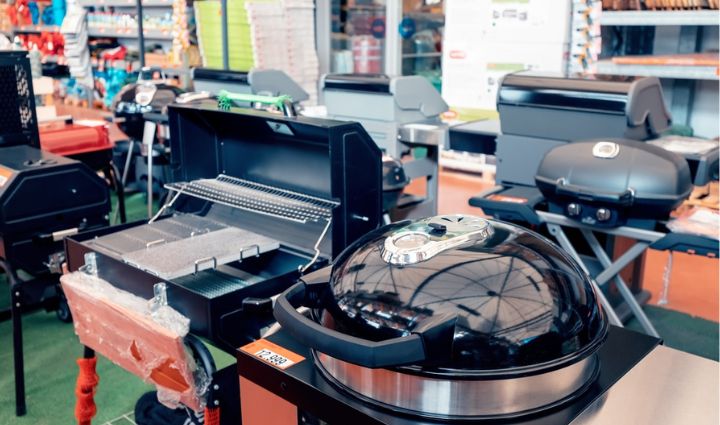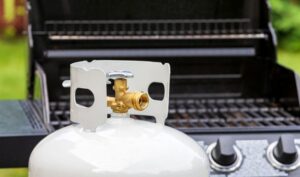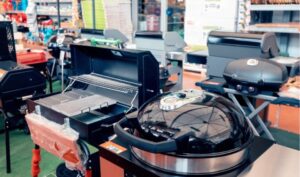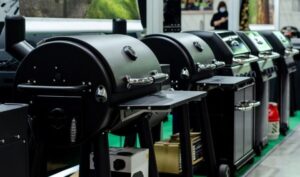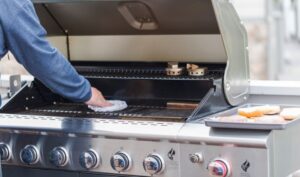This is Part 10 of GrillSpot’s Ultimate Gas Grill Buying Guide, where we’ll cover everything you need to know about how to buy a gas grill, from what factors you need to consider to detailed guides dedicated to everything from budget to grill size to BTUs.
Gas grills are made to survive rigorous use, but some are built from more durable materials than others. This is usually reflected in the cost of a new gas grill because it can significantly impact how long-lived your grill will be.
Gas grills are put through a lot in a single grilling season—exposure to the elements, moisture, incredibly high temperatures, grease, cooking debris, and smoke. How well you care for your grill has a major impact on its durability, but grills made with high quality materials and components will naturally have a longer lifespan compared to grills made with lower-quality materials, making BBQ grill materials an important factor when selecting which gas grill to bring home.
In this section of the Ultimate Gas Grill Buying Guide, we’ll take a look at the most common BBQ grill materials, including what are grills made of, which materials are the most durable, as well as maintenance routines and grill care.
Let’s dive in.
What Are Grills Are Made Of?
What metal to use for a BBQ grill is highly dependent on which part of the grill that material is used in. BBQ grill materials, from the body and knobs down to the gas fittings and burners, are almost always made using one of the following materials:
- Cast-aluminum
- Powder-coated steel
- Stainless steel
- Cast iron
- Plastic
- Brass
Some BBQ grill materials are better suited to small components, while others serve best as the grill body. Let’s take a closer look at these five materials, what components they are used for, how durable they are, and what grillers they are best suited for.
1. Cast-aluminum
Lightweight and rust-proof, gas grills made of cast-aluminum are often entry-level or budget grills. With that said, cast-aluminum is very durable and retains heat very well. Furthermore, the rust-proof aluminum typically requires less maintenance than grills made with other materials.
Common components: Grill body (burner box and/or grill lid)
Ideal For:
- Seasonal or occasional grillers
- First-time buyers and entry-level grillers
- Budget shoppers
2. Powder-coated steel
Powder-coated steel is covered with a protective coating of paint and is most commonly used on grill hoods and bodies. Available in a variety of colors including black, red, blue, and many others, it is a popular grill material that adds a flash of style among a sea of black and stainless steel options. As long as the protective coating remains intact, powdered-coated steel is very durable and relatively easy to clean, making it a more affordable and visually appealing alternative to the ubiquitous stainless steel.
Common components: Grill hood and body
Ideal For:
- Grillers looking for an attractive gas BBQ
- Seasonal or occasional grillers
- First-time buyers and entry-level grillers
3. Stainless steel
Stainless steel is one of the most commonly used BBQ grill materials, but you will find different grades or quality levels at different price points. The different grades indicate the mixture of metals used to make that specific steel. They all must have at least 11% chromium to be considered “stainless”, but grills that utilize lower quality stainless steel will be cheaper and typically won’t mention a specific grade number.
Here is a breakdown of the most common grades of stainless steel:
- 304: This is the most well-known grade of stainless steel and offers the most protection against rust (often called “commercial quality” or “commercial grade”).
- 316: Considered marine grade because of its increased resistance to corrosion. It’s a more expensive grade of stainless steel, but it’s applicable to all installation environments and is generally considered commercial grade.
- 316L: Similar to 316 stainless steel, but with a lower carbon content. This makes it less susceptible to cracking or corrosion at welded areas compared to 316 stainless steel.
- 443: Newer grade and similar in quality to 304 but more affordable. In time, this grade could become the material of choice in the grill industry.
- 430: Usually found on low price grills, this grade is the lowest quality and is more likely to rust sooner than 304 or 443.
Despite its name, stainless steel is anything but stainless. In outdoor settings, stainless steel can discolor and requires more frequent cleaning than powder-coated steel or cast-aluminum options. While it looks great, keep in mind that this is a higher maintenance material than its name might suggest.
Common components: Grill body, hood, grill grates, hinges, burners, bezels, carts
Ideal For:
- Grillers looking to upgrade to a better grill
- All-season grillers
4. Cast iron
Cast iron can be good and bad in a gas grill, depending on the grill owner. Because it is heavy and porous and therefore requires regular seasoning or a ceramic/enamel coating for maximum longevity, cast iron is typically only used for gas grill cooking grates. This adds to the overall weight of the grill, so if portability is a concern, look for lighter materials like stainless steel. Cast iron takes longer to heat up than other metals, but holds its heat very well once it’s up to temperature, and is the best material for achieving grill marks and a perfect sear.
Common components: Grill grates
Ideal For:
- Grillers who won’t skip on routine maintenance and care
- Grill lovers
- Foodies who love cast iron pans
5. Plastic
Many entry- and mid-level grills have exterior plastic components, such as knobs, bezels, and hooks. While plastic components are fairly durable, over time exposure to the elements will break down the plastic, making it more brittle and prone to cracking. To avoid pre-emptive damage, make sure you are covering your grill when it isn’t in use and storing it properly in the winter.
GRILLSPOT TIP: If your grill came with plastic knobs, you can upgrade them later with chrome or stainless steel knobs and bezels. Browse our collection of control knobs & bezels.
Common components: Knobs, bezels, and hooks.
6. Brass
Brass is a copper and zinc alloy. It is considered a non-sparking or spark-reduced metal and an excellent heat conductor, which makes it ideal for use in things like grill gas fittings and burners. Brass is softer than stainless steel, which makes it more prone to wear and corrosion. As a result, it is less expensive and typically only used for small component pieces that aren’t exposed to constant wear, like fittings and burners.
Common components: Fittings, burners.
Ideal For:
- Anyone
Which Gas Grill Materials Are the Most Durable?
Wondering what metal to use for a BBQ grill? High-quality stainless steel, such as grades 304 and 316L, is the most durable material for a gas grill. That said, it isn’t necessary for every single part of a grill to be made out of stainless steel. There are some areas where it won’t perform as well or as safely, which is why it’s okay (and sometimes recommended) to have other materials like brass as gas fittings, plastic knobs, or cast iron grill grates.
In addition to high-quality materials, you should also check any grill you are considering purchasing for the quality of its construction. Cheaper grills will be on carts that are assembled with nuts and bolts, while higher-quality grills will be constructed with welded joints and have stainless steel hinges.
When shopping for a new gas grill, don’t be afraid to put your potential new grill to the test by:
- Opening and closing the lids of floor models to try out the lid handle and test hinges
- Checking the wheels by rolling them if possible and noting whether it has two or four wheels
- Inspecting the joints and cart for sharp edges
- Generally getting a feel for how sturdy and stable the grill and its cart are
Gas Grill Maintenance Routines
Regardless of what grill materials you end up selecting, you will have to perform some grill maintenance and care in order to keep your grill functioning well and extend its lifespan. There are a few easy ways to do this:
- Clean your grill and grill grates after each use
- Routinely empty the grease trap
- Protect your grill with a cover when not in use
- Move your grill into storage in the off-season
- Perform the appropriate seasonal maintenance
Read our seasonal maintenance guides:
Wrapping Up
The materials that make up your grill are more important than you might think. Not only can material type and quality affect the overall cost, it can also impact a grill’s durability and overall lifespan. Choosing a grill with quality components that not only make sense for your budget and situation, but also your personal preference, is necessary to ensure the best possible grilling experience.

